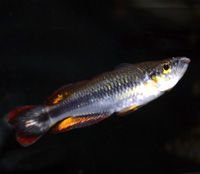Toadfish
Fish Fanatic
Common name/s: Madagascar Rainbow, Bowfish, Red Tailed Silverside
Scientific name: Bedotia Geayi, Bedotia Madagascariensis, Bedotia longianalis, Bedotia tricolor
Family: Bedotiidae
Origin: Rivers in Madagascar and only in Madagascar (indigenous species)
Maximum size: 6" but I haven't seen them larger than about 4"
Care: Clean, warm, planted and did I mention clean. Like all rainbows these guys like their water clean, frequent water changes and good (not necessarily strong) filtration. As for water chemistry I find a pH of around 7-7.4 is good. Hardness they're not to picky about (but avoid extreme highs). Plants are a great addition. They keep the water cleaner and the fish happier. I find swords such as Java Ferns quite effective but any plant that isn't too sensitive will work. The more sensitive plants can be destroyed by the movement of the fish. Speaking of which, these fish need their swimming space so avoid dense planting.
Feeding: A staple or colour enhancing food of good quality is fine as long as it is offset with frozen blood worms or shrimp (I prefer using MYSIS shrimp). A note about staple foods: try and get one that doesn't sink too fast as the Madagascar rainbow prefers to feed at the surface.
Breeding: This is where the plants come in handy: the eggs are scattered in fine leaved (but hardy) plants, like Hornwort or Java Moss. The male will then come up behind chasing the female as he fertilizes the eggs. Then, once hatched (5-7 days), you must feed newly hatched brine shrimp.

Male Madagascar Rainbow
I'll be getting around to updating more Rainbow information, so stay tuned.
Scientific name: Bedotia Geayi, Bedotia Madagascariensis, Bedotia longianalis, Bedotia tricolor
Family: Bedotiidae
Origin: Rivers in Madagascar and only in Madagascar (indigenous species)
Maximum size: 6" but I haven't seen them larger than about 4"
Care: Clean, warm, planted and did I mention clean. Like all rainbows these guys like their water clean, frequent water changes and good (not necessarily strong) filtration. As for water chemistry I find a pH of around 7-7.4 is good. Hardness they're not to picky about (but avoid extreme highs). Plants are a great addition. They keep the water cleaner and the fish happier. I find swords such as Java Ferns quite effective but any plant that isn't too sensitive will work. The more sensitive plants can be destroyed by the movement of the fish. Speaking of which, these fish need their swimming space so avoid dense planting.
Feeding: A staple or colour enhancing food of good quality is fine as long as it is offset with frozen blood worms or shrimp (I prefer using MYSIS shrimp). A note about staple foods: try and get one that doesn't sink too fast as the Madagascar rainbow prefers to feed at the surface.
Breeding: This is where the plants come in handy: the eggs are scattered in fine leaved (but hardy) plants, like Hornwort or Java Moss. The male will then come up behind chasing the female as he fertilizes the eggs. Then, once hatched (5-7 days), you must feed newly hatched brine shrimp.

Male Madagascar Rainbow
I'll be getting around to updating more Rainbow information, so stay tuned.





